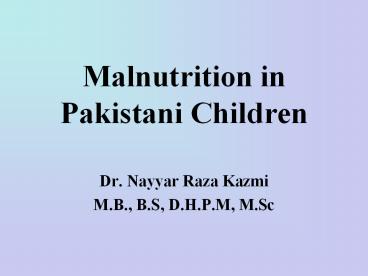Malnutrition in Pakistani Children - PowerPoint PPT Presentation
Title:
Malnutrition in Pakistani Children
Description:
Malnutrition in Pakistani Children Dr. Nayyar Raza Kazmi M.B., B.S, D.H.P.M, M.Sc Learning Objectives To understand the burden of Malnutrition in Pakistan. – PowerPoint PPT presentation
Number of Views:70
Avg rating:3.0/5.0
Title: Malnutrition in Pakistani Children
1
Malnutrition in Pakistani Children
- Dr. Nayyar Raza Kazmi
- M.B., B.S, D.H.P.M, M.Sc
2
Learning Objectives
- To understand the burden of Malnutrition in
Pakistan. - To understand the etiology of Malnutrition.
- To know the factors useful in identifying
Malnutrition in children. - To know the treatment options available for
Malnutrition. - To know preventive strategies available for
preventing Malnutrition.
3
Performance Objectives
- By the end of the lecture, the students should be
able to - Know the high risk groups for Malnutrition.
- Be able to diagnose Malnutrition and classify it.
- Be able to offer treatment for Malnutrition.
- Be able to understand and demonstrate the
importance of Prevention of Malnutrition. - Be able to demonstrate, how to make simple
calorie rich foods.
4
What is Malnutrition
- Malnutrition is defined as a pathological state
resulting from relative or absolute deficiency of
one or more essential nutrients. It is primary
when there is deficiency of food available or
secondary when food is available but the body
cannot assimilate it for one or another reason. - Malnutrition is common in children between age of
3 months and 3 years.
5
Anthropometric Indices in Malnutrition
- Weight for age is the best screening tool.
- Weight for age below 2 Standard Deviation from
median is taken as Malnutrition. - It is used for mass screening of children to
detect under nutrition. - Weight for Height below the 5th Centile
classifies the child as Wasted ( Acute
Malnutrition). - Height for age below the 5th centile classifies
the child as Stunted (Chronic Malnutrition)
6
Malnutrition in Pakistan
- 38 of Children are Low Weight for Age.
(Shakirullah et el. JCN, 1999,vol.xii) - 14 of Children are Wasted
- 36 or Urban and 44 of rural Children are
Stunted. - Malnutrition is responsible as underlying factor
for 55 of Deaths in Children under 5 years of
age. (Nelson textbook of Pediatrics, 16th Ed.
Saunders, 2001)
7
Etiology of Primary Malnutrition
- Failure of Lactation.
- Improper Weaning Practices
- Poverty
- Food Taboos
- 2 or more children under 5 years of age in same
household - Death of Mother
- Incompetent/ Ignorant Mother.
- Lack of Family Planning
8
Etiology of Secondary Malnutrition
- Lack of Immunization
- Congenital Diseases ASD, VSD, cleft palate etc.
- Malabsorption Celiac Disease, Lactose
intolerane, Giardiasis, Cystic Fibrosis - Metabolic Inborn errors of Metabolism, CRF,
Renal tubular Acidosis etc. - Infections Tuberculosis ( very common in
Pakistan)
9
Clinical features in Marasmus
- Marked muscle wasting and loss of subcutaneous
fat. - Monkey Facies
- Skin becomes loose and hangs in folds
- Abdomen protuberant due to hypotonic muscles
- Temperature is usually sub-normal
- Child is alert
10
Clinical features of Kwashiorkor
- Generalized Edema more marked in Lower
Extremeties. - Apathy and Irritability
- Fine, sparse and discoloured hair
- Anemia
- Usually Flaky Paint Dermatitis
- Enlarged Liver due to Fatty Changes
11
Lab Investigations in Malnutrition
- Check Hemoglobin in all cases. It is usually low.
Sometimes it may be normal despite severe pallor
in child because of the associated dehydration
and hemoconcentration, the Hb apparently seems to
be normal. - If there is no BCG Scar, do Diagnostic BCG and
read after 72 hours. If more than 10 mm of
induration, treat as Tuberculosis. - Do Stool R/E and Urine R/E.
- Do Chest Xray in all cases of Malnutrition.
- Serum Pre-Albumin level. This is the most
sensitive prognostic indicator in Kwashiorkor. Do
on Day1, Day 5 and before discharge of the
patient. - Plasma Protiens and Serum Albumin level. These
are usually very low in Kwashiorkor.
12
Complications of Malnutrition
- Hypothermia
- Hypoglycemia
- Cardiac Failure
- Infections
- Vitamin A Deficiency
- Severe Anemia
- Dermatosis
13
Treatment of Malnutrition
- Follow WHO Guidelines
- 1. Treat/prevent hypoglycaemia
- 2. Treat/prevent hypothermia
- 3. Treat/prevent dehydration
- 4. Correct electrolyte imbalance
- 5. Treat/prevent infection
- 6. Correct micronutrient deficiencies
- 7. Initiate refeeding
- 8. Facilitate catch-up growth
- 9. Provide sensory stimulation and emotional
support - 10. Prepare for follow-up after recovery
14
Therapeutic Nutrition in Malnutrition
- Start slowly with F-75. If that is not available,
give traditional easy to make, calorie rich
foods. - For those having severe anorexia, feed overnight
with Milk given through NG tube, till appetite
returns. - Give Vitamin A, Vitamin D, Zinc, Magnesium, and
folate to all children - Treat Oral thrush, if present.
15
Prevention of Malnutrition
- Primary Prevention
- Health Education to mothers about good nutrition
and food hygiene through Lady Health Workers - Immunization of children.
- Growth monitoring on Growth Charts specially of
all children under 3 years of age - Secondary Prevention
- Mass Screening of high risk populations, using
simple tools like Weight for age or MUAC. - Tertiary Prevention
- Good Nutritional Care, supplementary feedings and
rehabilitation, counselling of mothers.

